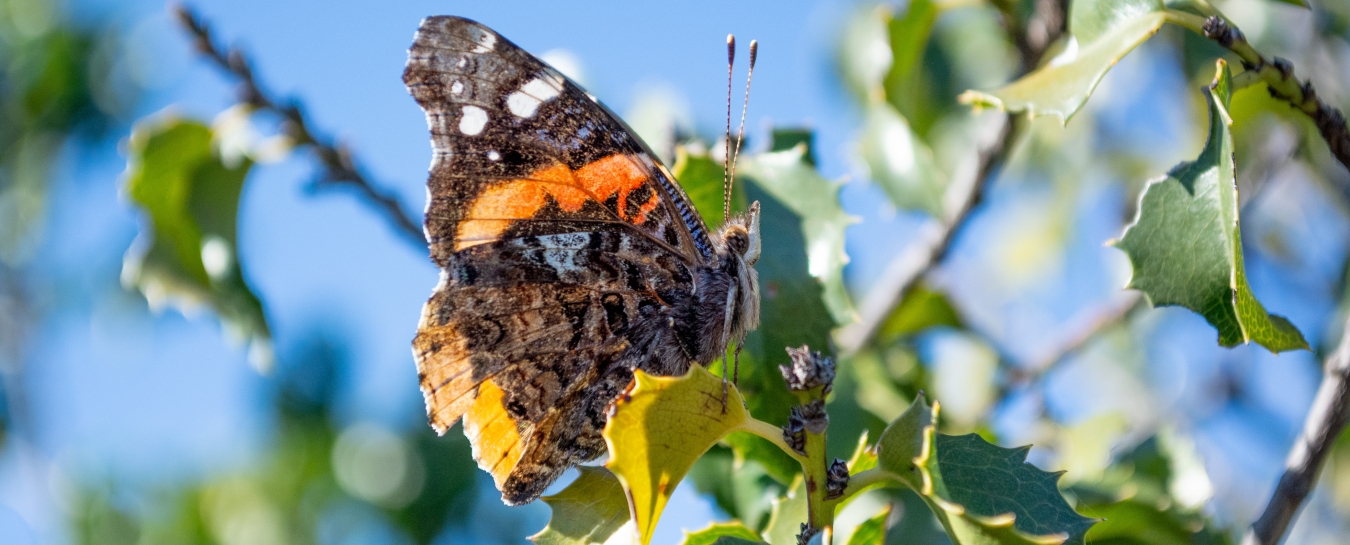
Central Coast Butterfly FAQ
What are common butterflies of the Central Coast region? / How can I ID this butterfly I saw?
A great way to start learning about local butterfly diversity is to visit our Entomology Department’s Santa Barbara Butterflies website. Begin the process of identifying a wild butterfly based on its appearance on the page with links to browse by family. If you know the species name and want to learn more, browse butterflies by species.
In our region, six families and over 100 species of butterflies have been recorded! On each species page, you can find images of the butterfly’s uppersides and undersides, with additional examples in the case of species that have different color morphs (different color variations) or display sexual dimorphism (males and females appearing different). If you have good images of a butterfly you’re trying to identify but you can’t find a good match on the Santa Barbara Butterflies site, ask a curator here.
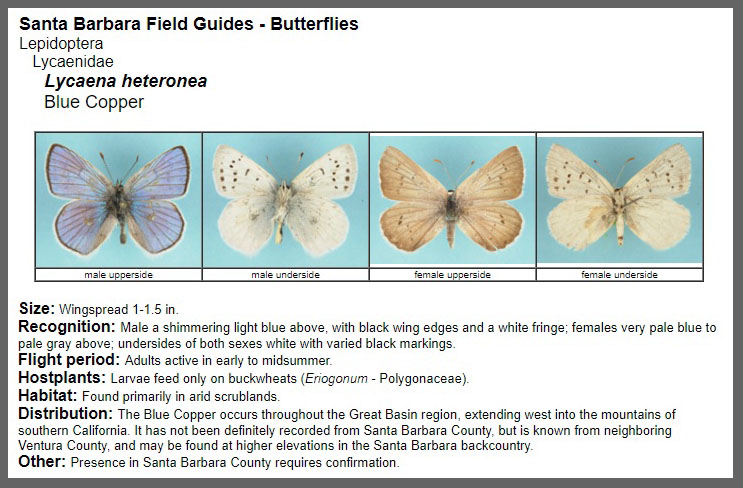
An example of what you can learn on a species page of the Santa Barbara Butterflies site
For information about butterflies outside our region, we highly recommend both BugGuide.net for U.S. and Canadian insects, and Learn About Butterflies for information about butterflies around the world.
Why are Monarchs a big deal in this region?
Monarch butterflies (Danaus plexippus) are an iconic insect because they’re boldly patterned and widely recognized, and many individuals of the species embark on an extraordinary migration in an annual cycle. They have long been tied with the culture of Coastal California, thanks to their habit of overwintering in large, conspicuous groups in the tallest trees in our area. These groups have even reached the level of tourist attraction in some areas, especially in Pacific Grove in Monterey County. Incidentally, while Monarch butterflies are popularly considered a “poster child” for pollinators due to their charismatic appearance, other insects—particularly bees—seem to contribute more to pollination in our ecosystems. However, pollen does cling to Monarch mouthparts, legs, and body, so they almost certainly do fulfill this role to some degree.
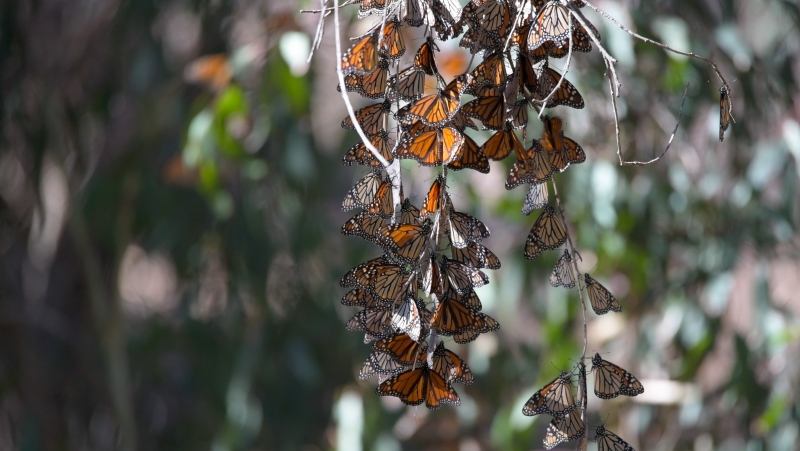
A cluster of overwintering Monarchs at Ellwood Butterfly Grove in Goleta, late November 2021
What are the characteristics of the Monarch butterfly?
Adult Monarch butterflies are relatively large butterflies, with a wingspan of up to about 4.5 inches. They are distinctively bright orange with black veining on both the uppersides and undersides and black around the edges with white spotting. The famous Monarch mimic, the Viceroy butterfly (Limenitis archippus), does not occur over most of California, but it can be distinguished by the continuous black line cutting diagonally across the hind wing. The most similar butterfly to the Monarch in the Santa Barbara region is the Queen butterfly (Danaus gilippus), which is a close relative of the Monarch. It is similar in proportions, but is more brick-red in color and only has strong black veining on the underside of the hind wing. Queens occur in the Santa Barbara area uncommonly; like Monarchs, the caterpillars also feed on milkweed plants.
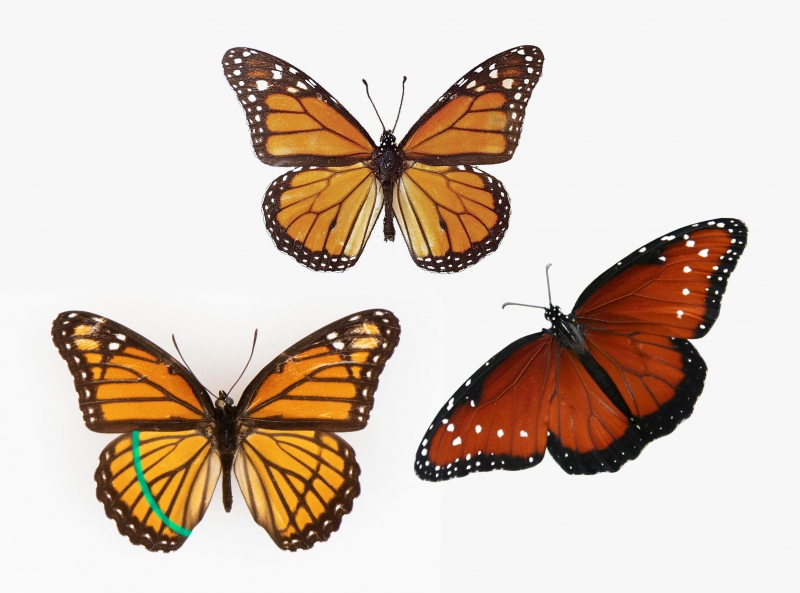
The diagonal line (highlighted in green in this graphic) helps distinguish the Viceroy (bottom left) from a Monarch (top). The Queen (lower right) is a deeper red color.
Male and female adult Monarchs are quite similar to each other (i.e., the Monarch is not very sexually dimorphic), but can be readily distinguished by looking at their uppersides: males have thinner black veining, and have an oval patch along one of the veins near the middle of the hind wing. Females have thicker veining and no patch.
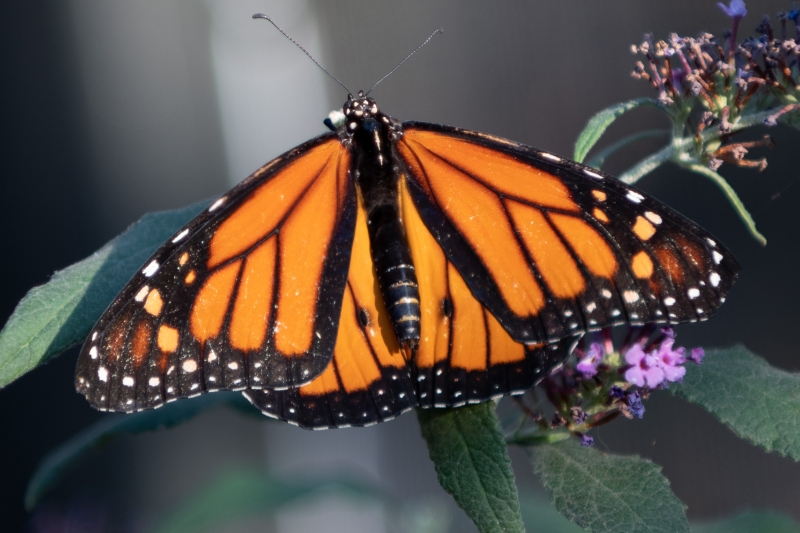
The marks that look like little black grains of rice—on the wing veins lined up at either side of the rear abdomen here—identify this individual as a male Monarch.
Monarch caterpillars are also very distinctive—they have thin black, yellow, and white bands across the back, and have two pairs of long, black filaments sticking up off the back, one pair near the head and one pair near the rear end. The only other caterpillar in our region that comes close to fitting this description is that of the Queen; conveniently for recognition, however, the Queen has an extra pair of black filaments near the middle of the back!
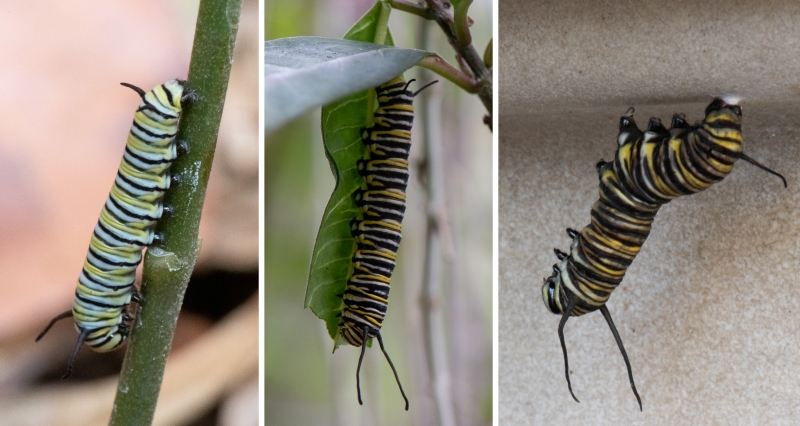
Monarch caterpillars at a few different stages of life. The caterpillar at left belongs to an early phase and is less than half the size of the older caterpillar in the center. Monarch caterpillars eat a lot of milkweed, gaining nearly 2,000x their original mass before they pupate. The caterpillar at right is preparing to pupate and has secreted silken thread to attach itself to a flowerpot.
The Monarch pupa or chrysalis is also distinctive, as well as beautiful. They are uniformly pale green, but have a black line across the upper half that is edged with metallic highlights that almost appear to be gold leaf. Other “gold leaf” spots appear on the lower half as well.
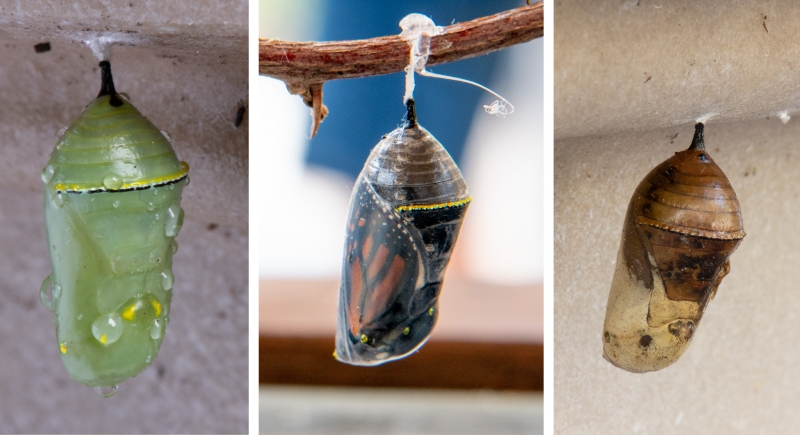
Left, a new Monarch chrysalis with golden highlights. Center, the chrysalis becomes more transparent as the butterfly is ready to emerge. Right, a chrysalis that has been attacked by a parasitoid wasp.
As a result of their habit of feeding on milkweed plants as caterpillars, Monarchs are highly chemically defended, even as chrysalides and adults. Milkweed plants contain latex that is full of cardiac glycosides, which are highly toxic to most potential predators. Monarch caterpillars accumulate these toxins as they feed, which means they are even more toxic than the milkweed they eat! Bright orange or red coloration like that found in adult Monarchs is a repeating pattern in nature, and serves as a sort of standard warning system to predators: “Don’t eat me—I’m poisonous!” This evolved warning system is called aposematism, or aposematic coloration.
Where can I find out how Monarchs are doing in my region?
To drill down into the numbers of migrating Monarchs in our own region, visit the website Western Monarch Count for constantly updated information.
On July 21, 2022, Monarchs throughout the Americas made the news when the International Union for Conservation of Nature (IUCN) added the migratory Monarch subspecies (Danaus plexippus plexippus) to its IUCN Red List of Threatened Species™ as endangered. In 2023, the IUCN reclassified it as vulnerable, but the results of the 2024 early season-count led by Western Monarch Society are not promising. In this statement released November 15, 2024, Xerces Society Conservation Biologist Isis Howard describes the bigger picture:
"We know that Monarch butterfly populations, like other insects, are naturally "bouncy" in that they fluctuate from year to year in response to the temperature, rainfall, the availability of food, and other factors like predation and disease. However, the migratory Western Monarch population has undergone a sustained and significant decline—estimated at over 95% since the 1980s—far beyond any year-to-year fluctuations. While there are still yearly ups and downs, Western Monarch populations are now bouncing around in uncharted territory. We witnessed migratory Monarchs rebound from severely low overwintering numbers before, and a similar uptick in future years may be possible but is not guaranteed. Once again, we call upon all butterfly lovers, conservationists, land stewards, policy makers and educators to help us spread the word of Western Monarch declines and encourage immediate action to aid this beloved butterfly and its habitat."
The U.S. government has not federally listed the Monarch as endangered, so it is not protected in the U.S. by the Endangered Species Act.
What’s the story with Monarch migration?
Scientists are still figuring out the details of how and why Monarch butterflies migrate, and even the actual patterns of migration. For example, it was long thought that Monarchs in North America could be clearly divided between an eastern migratory population (east of the Rocky Mountains) that overwintered in a small region in Michoacán, central Mexico, and a western migratory population (west of the Rocky Mountains) that overwintered along the California and Baja California coast. While rough observation supports this idea, genetic analysis of these supposedly distinct populations shows that the two seem to be interbreeding! To make things more complex, Monarchs were also recently discovered to overwinter in parts of Arizona. All of this implies that Monarchs may be responding to cues in their surroundings, rather than being genetically hard-wired to migrate to certain places. Additionally, there are large numbers of individuals (possibly increasing—see below) that do not migrate and simply remain in climates that are warm year-round.
Interestingly, the western (California) overwintering populations were first recorded only in the 1860s, and occurred exclusively on the native Monterey Pine (Pinus radiata). In recent times, most roost sites consist of groves of tall Eucalyptus trees planted by humans. You may be surprised to learn that beginning in the 1800s, Monarchs spread to many other parts of the world, where established populations now occur. This includes northern South America, Spain, islands in the North Atlantic Ocean, Hawaii, islands across the South Pacific Ocean, New Zealand, Australia, New Guinea, and islands off Southeast Asia. Many of these populations are non-migratory.
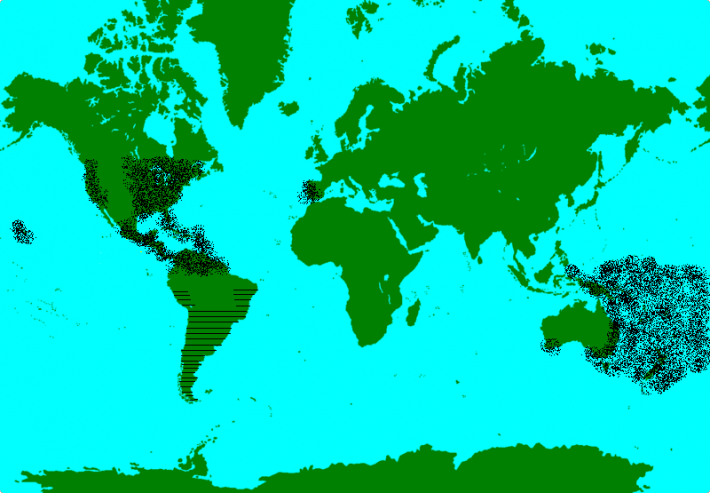
This map representing global distribution of Monarchs is by the conservation nonprofit Monarch Joint Venture. The tiny black dots represent the range of the Danaus plexippus (the Monarch) and the striped areas represent the range of a sister species, Danaus erippus (the Southern Monarch).
Locally, what do Monarchs do/where do they go throughout the year?
We have two different populations of Monarchs in the Santa Barbara region: a resident population (which lives and reproduces in our area and doesn’t bother to migrate), and a migratory population that overwinters in our region. The two populations reproduce on different schedules and their numbers fluctuate based on many variables. The migratory/overwintering population breeds earlier in spring, right after they wake up from their winter diapause (a period when they conserve their energy as they await the best conditions to reproduce). It’s not completely clear whether these two populations are genetically distinct, or whether there is significant exchange between them.
The migratory/overwintering population in the Santa Barbara region probably populates the interior southern desert regions of the Southwestern US once the weather becomes warmer. We have a specimen in the collection at SBMNH that was originally given a wing tag during fall 1987 in Southern California, but was subsequently collected a few months later during April 1988 in southeastern Arizona!
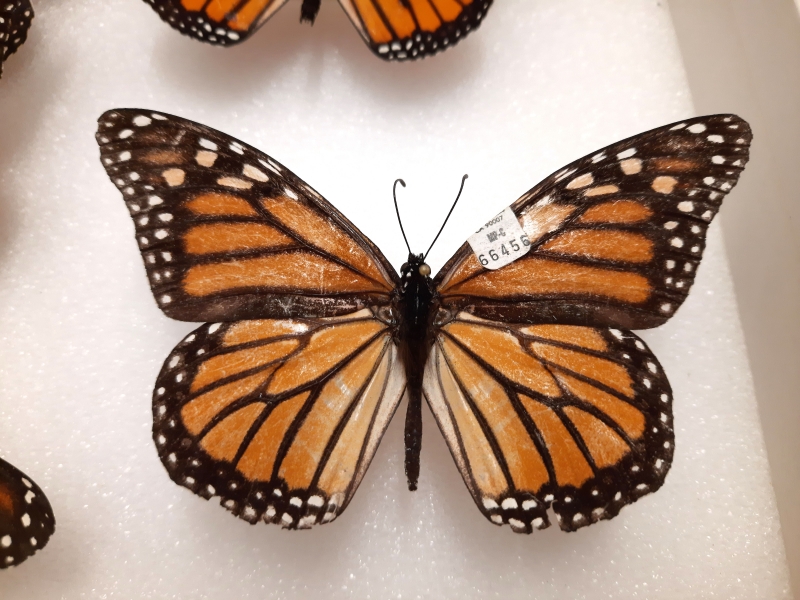
Thanks to the wing tag, we know that this individual butterfly flew 500 miles! Photo by Matt Gimmel
How can I help Monarch butterflies?
Planting milkweed—the host plant for Monarch caterpillars—is a very popular way to help. You may want to either plant a California native milkweed (an excellent overview of our native milkweeds can be found here) that naturally dies back out of season. Another option is to cut back Tropical Milkweed (Asclepias curassavica) in winter to discourage the microscopic protozoan Monarch parasite Ophryocystis elektroscirrha (OE for short) from potentially building up on your plants.
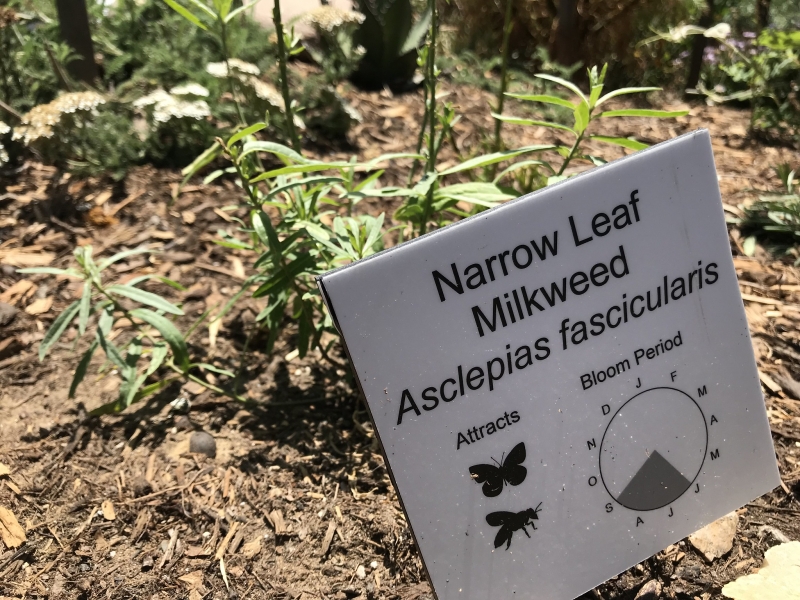
Native milkweed photo by Joanna Gilkeson/USFWS
Your milkweed strategy may differ depending on where you live and which Monarch population you want to encourage. If you live on the coast and want to encourage resident Monarchs, you can plant milkweed to support the hungry Monarch caterpillars or residents who breed here. If you want to encourage the migrating population, you could avoid planting milkweed here on the coast, or at least be sure to cut it back or let it die back in winter, when migrants are present. Some conservationists even suggest that people don’t plant milkweed at all in the overwintering areas like the Central Coast, and do plant milkweed in the Central Valley and Sierra Nevada foothills, where migrants historically go to breed and lay eggs. Those authorities say the best thing we can plant in the overwintering areas are plants which will provide nectar to give migrating butterflies energy for their long journey. It’s like having gas stations along the way, with a romantic luxury hotel at the end as a big signal to the butterflies: “lay eggs here!” For the migrating Monarchs, the Central Coast (especially Goleta) can be a great gas station if we have foliage for them to shelter in as they overwinter, and nectar-rich plants to drink from when they awake from their diapause. Whether you plant milkweed or nectar plants, make sure the plants intended to help butterflies haven’t been treated with insecticide, either by you or the original plant grower/vendor. Even “natural” insecticides target insect nervous systems, which butterflies obviously have.
Regardless of where we live and which population we want to support, we can all help butterflies by protecting butterfly habitat and providing nectar plants if we have space to cultivate. For more detailed information about the variety of strategies we can use to help Monarchs in our region, check out the Xerces Society’s Western Monarch Call to Action.
I found an injured or sick butterfly. What can I do to help it?
While watching a butterfly struggling to fly or being lethargic, particularly if it is freshly emerged from its chrysalis, can be a sad event, try not to fret—this is not necessarily a sign that something is wrong. We do often fret about large, sudden, population-level die-offs of insects, but keep in mind that the majority of Monarch eggs laid in nature don’t make it to adulthood due to developmental issues, suboptimal weather, disease, predation, or parasitoid insects, and these afflictions can occur at any life stage. Also, non-migratory adult Monarchs typically live only 2–5 weeks, so the chances of a given butterfly being close to its “expiration date” are quite high. Yes, being an insect is naturally rough! We discussed some of these struggles of butterfly life in episode six of our Butterfly Magic Window series, which offers a behind-the-scenes look at our recurring summer exhibit Butterflies Alive!
What are the best plants for butterfly gardening and where can I find them?
First things first—you should be clear on what function you want your butterfly garden to have. Do you want to provide ample nectar for adult butterflies passing through your area? Or do you want to provide host/food plants for caterpillars of a particular (or a variety of) native species, thus attracting adult females to lay eggs? Perhaps both? Different answers to these questions have distinct implications for which plants you should select. Other factors to consider are the characteristics of the area where your garden is located, including humidity, temperature extremes, level of shade, and soil characteristics.
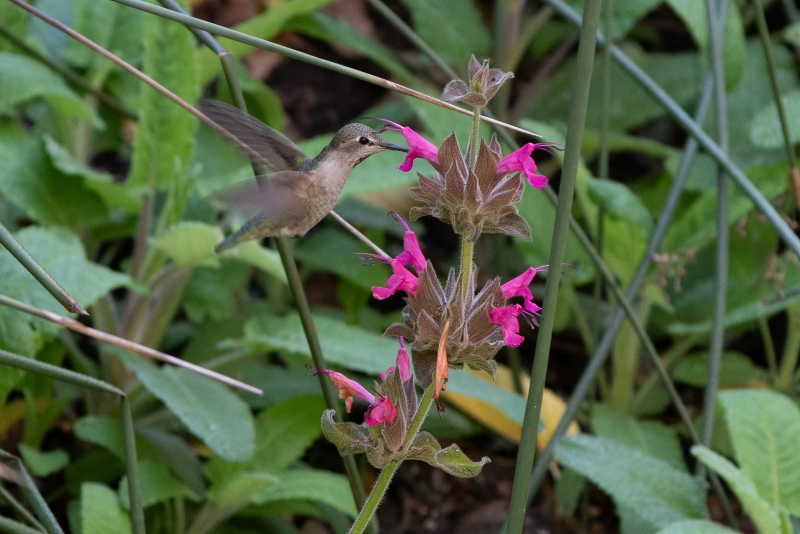
Hummingbird Sage is a good food source for hummingbirds and butterflies alike.
An excellent list of butterfly-garden plants specific to the Santa Barbara foothills was provided by SBMNH Collection Associate Sandy Russell at the North American Butterfly Association’s website. Note that the list is divided up by butterfly nectar flowers vs. caterpillar food plants.
There’s a fantastic place to find inspiration, information, and native plants just around the corner from the Museum’s Mission Canyon campus: Santa Barbara Botanic Garden.
I want to help butterflies, but butterfly gardening isn’t an option for me. How can I get involved?
You can contribute to citizen science that helps inform conservation measures. We love the app iNaturalist because any casual sightings you post there go into their citizen science database and can aid researchers. If you have more time to dedicate, you can get involved a little more seriously by assisting the annual Western Monarch Count.
Stay alert to local news for opportunities to weigh in on land use issues that affect butterflies. One way to stay on top of these issues here on the Central Coast is to pay attention to organizations like Land Trust for Santa Barbara County, Ventura Land Trust, Environmental Defense Center, Community Environmental Council, and Channel Islands Restoration.
Finally, you can support organizations that are helping. If you value the expertise and education we provide, please consider making a donation to the Museum. We appreciate any amount. In summer each year, you can even become a butterfly sponsor to enjoy some extra benefits, including recognition. If you want to make sure expertise on native plants is preserved for future generations and native plants are made available locally, support our neighbors Santa Barbara Botanic Garden and the small local businesses that also provide native plants.
What did we miss?
Have a Central Coast butterfly question that isn’t addressed here? Write us at info@sbnature2.org to submit a suggestion so we can continue to build this resource in response to community interest.

